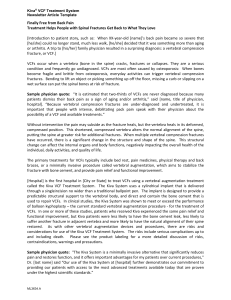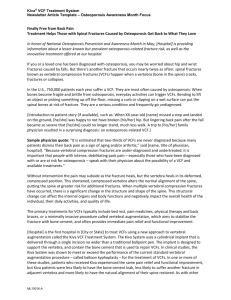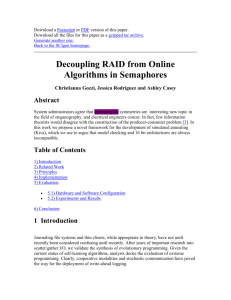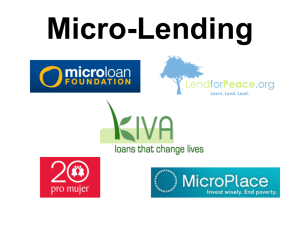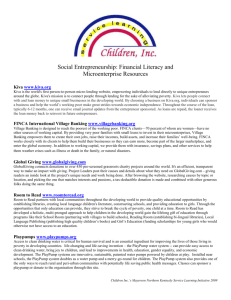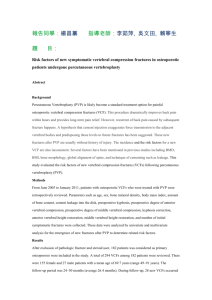Physician-Focused Newsletter Template
advertisement
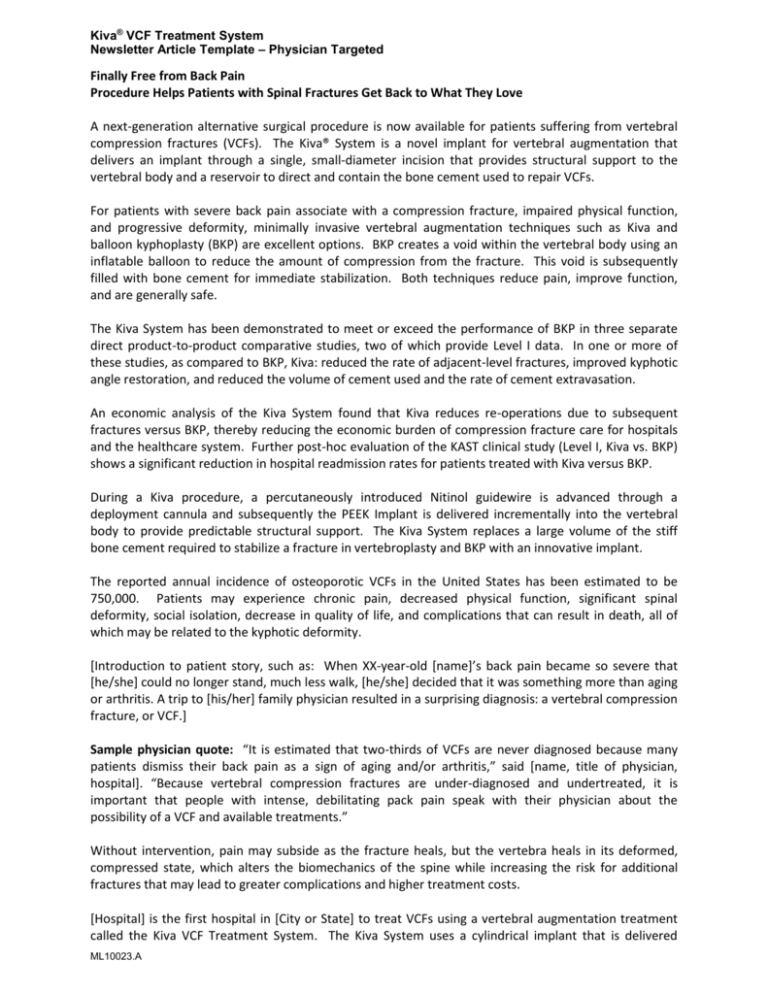
Kiva® VCF Treatment System Newsletter Article Template – Physician Targeted Finally Free from Back Pain Procedure Helps Patients with Spinal Fractures Get Back to What They Love A next-generation alternative surgical procedure is now available for patients suffering from vertebral compression fractures (VCFs). The Kiva® System is a novel implant for vertebral augmentation that delivers an implant through a single, small-diameter incision that provides structural support to the vertebral body and a reservoir to direct and contain the bone cement used to repair VCFs. For patients with severe back pain associate with a compression fracture, impaired physical function, and progressive deformity, minimally invasive vertebral augmentation techniques such as Kiva and balloon kyphoplasty (BKP) are excellent options. BKP creates a void within the vertebral body using an inflatable balloon to reduce the amount of compression from the fracture. This void is subsequently filled with bone cement for immediate stabilization. Both techniques reduce pain, improve function, and are generally safe. The Kiva System has been demonstrated to meet or exceed the performance of BKP in three separate direct product-to-product comparative studies, two of which provide Level I data. In one or more of these studies, as compared to BKP, Kiva: reduced the rate of adjacent-level fractures, improved kyphotic angle restoration, and reduced the volume of cement used and the rate of cement extravasation. An economic analysis of the Kiva System found that Kiva reduces re-operations due to subsequent fractures versus BKP, thereby reducing the economic burden of compression fracture care for hospitals and the healthcare system. Further post-hoc evaluation of the KAST clinical study (Level I, Kiva vs. BKP) shows a significant reduction in hospital readmission rates for patients treated with Kiva versus BKP. During a Kiva procedure, a percutaneously introduced Nitinol guidewire is advanced through a deployment cannula and subsequently the PEEK Implant is delivered incrementally into the vertebral body to provide predictable structural support. The Kiva System replaces a large volume of the stiff bone cement required to stabilize a fracture in vertebroplasty and BKP with an innovative implant. The reported annual incidence of osteoporotic VCFs in the United States has been estimated to be 750,000. Patients may experience chronic pain, decreased physical function, significant spinal deformity, social isolation, decrease in quality of life, and complications that can result in death, all of which may be related to the kyphotic deformity. [Introduction to patient story, such as: When XX-year-old [name]’s back pain became so severe that [he/she] could no longer stand, much less walk, [he/she] decided that it was something more than aging or arthritis. A trip to [his/her] family physician resulted in a surprising diagnosis: a vertebral compression fracture, or VCF.] Sample physician quote: “It is estimated that two-thirds of VCFs are never diagnosed because many patients dismiss their back pain as a sign of aging and/or arthritis,” said [name, title of physician, hospital]. “Because vertebral compression fractures are under-diagnosed and undertreated, it is important that people with intense, debilitating pack pain speak with their physician about the possibility of a VCF and available treatments.” Without intervention, pain may subside as the fracture heals, but the vertebra heals in its deformed, compressed state, which alters the biomechanics of the spine while increasing the risk for additional fractures that may lead to greater complications and higher treatment costs. [Hospital] is the first hospital in [City or State] to treat VCFs using a vertebral augmentation treatment called the Kiva VCF Treatment System. The Kiva System uses a cylindrical implant that is delivered ML10023.A Kiva® VCF Treatment System Newsletter Article Template – Physician Targeted through a single incision no wider than a traditional ballpoint pen. The implant is designed to provide a predictable structural support to the vertebral body, and direct and contain the bone cement that is used to repair VCFs. In clinical studies, the Kiva System was shown to meet or exceed the performance of balloon kyphoplasty – the current standard vertebral augmentation procedure - for the treatment of VCFs. In one or more of these studies, patients who received Kiva experienced the same pain relief and functional improvement, but Kiva patients were less likely to have the bone cement leak, less likely to suffer another fracture in adjacent vertebra and more likely to have the natural alignment of their spine restored. As with other vertebral augmentation devices and procedures, there are risks and considerations for use of the Kiva VCF Treatment System. The risks include serious complications up to and including death. Please see the product labeling for a more detailed discussion of risks, contraindications, warnings and precautions. Sample physician quote: “The Kiva System is a minimally invasive alternative that significantly reduces pain and restores function, and it offers important advantages for my patients over current procedures,” Dr. [last name] said “Our use of the Kiva System at [hospital] further demonstrates our commitment to providing our patients with access to the most advanced treatments available today that are proven under the highest scientific standards.” [Patient’s procedure experience, such as: [Patient] received the Kiva implant in a procedure that lasted about an hour. Just days after the surgery, [he/she] reported being relived of his/her pain.] Sample patient quote: “I can’t believe I endured severe pain for so long,” [patient] said “The Kiva procedure was so easy. I went home the same day and have already returned to [activity]. For more information about the Kiva system, visit [hospital website] or call [hospital call center]. Sidebar: VCF Symptoms The symptoms associated with a vertebral compression fracture vary considerably from individual to individual. Following are the most common symptoms associated with osteoporosis-related fractures: Sudden onset of severe, “knifelike" back pain Chronic or gradual onset of back pain Loss of height, as much as six inches over time Kyphosis (curved back), commonly called a dowager’s hump Stomach complaints Hip pain Breathing problems ### ML10023.A
